What is a hyacinth? This is an incredibly beautiful and versatile plant in many ways. In the garden, the flower blooms the very first and signals the arrival of spring. It is not only his rich palette of colors that strikes the imagination, but also the orderly collected brushes, consisting of terry or ordinary bells. Among flower growers, a bouquet of cut motley panicles can often be seen even in a vase. And if you create a suitable microclimate for plants in the room, then you won’t have to pick them anymore. In your home, these wonderful flowers will feel great on the windowsill in pots. The article will talk about the features of growing them indoors.
What is a hyacinth?
First of all, it is an excellent representative of the flora with high decorative qualities. Its flowers come in a variety of shades: pink, white, burgundy, purple, purple, pale yellow and black. Hyacinth was originally intended forgrowing outdoors. Its name speaks for itself, since in Greek it means "rainy flower". Indeed, after the first precipitation falls against the background of spring soil, colorful bells immediately bloom.
If we talk about what hyacinth is from the point of view of floriculture, then this is a universal representative grown for several purposes. It can be seen in summer cottages and adjacent territories of private mansions. It is also grown for sale, since the flowers can be stored for some time in cut form. Houseplant lovers successfully keep it on their windowsills.
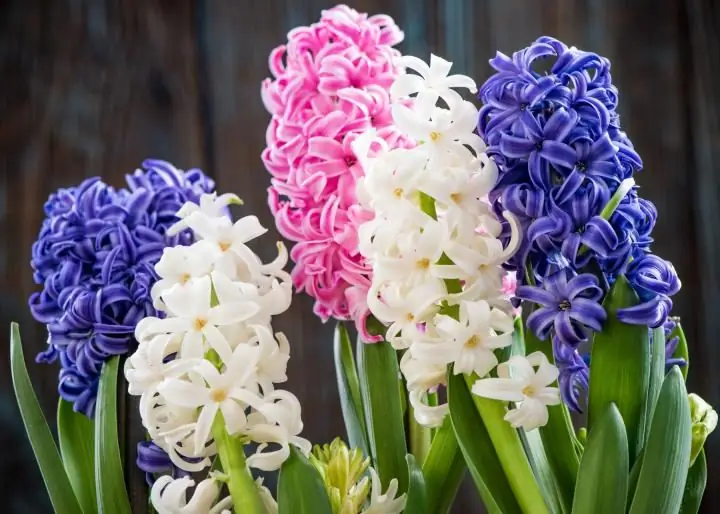
Botanical characteristics of the plant
The original bush of the plant is a leaf rosette, from which a rather juicy stem emerges. The peduncle, depending on the variety, can be both high and short. Numerous bells tightly border the upper part of the stem, gathering in one brush. Leaf plates have a bright green color, a smooth surface and a fleshy structure. The nutritional system of a spring flower looks like an onion, consisting of succulent leafy layers, tightly adjacent to each other. The stem of the plant originates at the base of the bottom of the root system.
Botanical characteristics of plants also depend on varietal characteristics. Although there are many hyacinths, according to official statistics they are divided into three main groups:
- Oriental. It is the most popular flower from which manydecorative varieties. Its habitat in the wild is Greece, Dalmatia and Asia Minor. The plant is distinguished by a thin stem and a rare arrangement of bells, a variety of colors and an alluring aroma.
- Transcaspian. Hyacinth with a rather high peduncle, most often shoots two arrows. The color is pale blue. Grows wild in the mountains.
- Litvinova. An annual variety of different sizes. It stands out against the background of others with its charming beauty and wider leaf plates. Among this variety there are specimens with purple, blue and even with a greenish color of flowers. Under natural conditions, it grows on the territory of Turkmenistan and Iran.
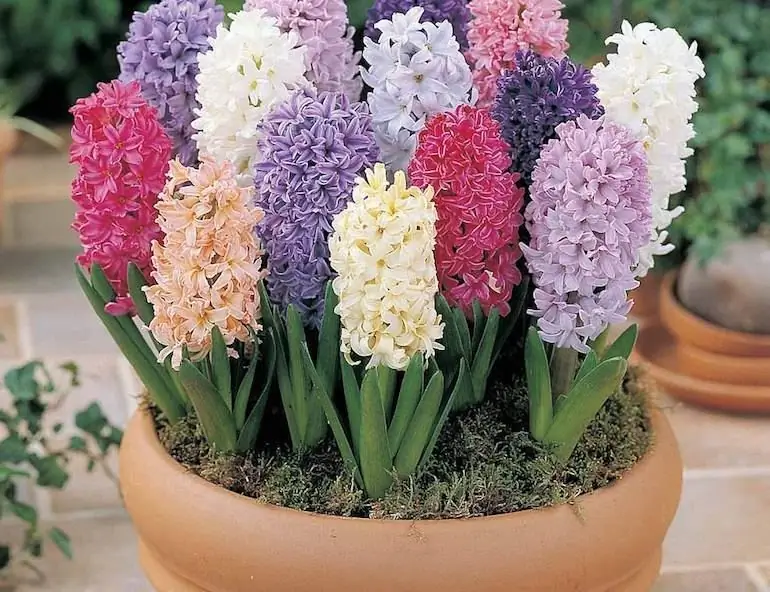
What do flowers love?
In order for the hyacinth to develop normally in a homely atmosphere and please the owner with its beautiful flowers, he needs conditions similar to garden ones. It cannot be concluded that there is too much difference between these methods, but there are some nuances and secrets. Experienced flower growers were able to understand the nature of this plant and learned how to grow it in different conditions. Since this is a spring flower, the initial temperature when bringing a pot with a bush into the room should be cool. He needs to provide good lighting, with the presence of sunlight.
The most necessary condition in the home planting of hyacinths is the method of agricultural technology, aimed at accelerating the development of the bush until the buds appear. Forcing a plant is a complex of flower growing techniques,which allows you to reach the peak of the most beautiful cycle for a specific period or date. Using this method, the plant will provide you with bright bouquets for a holiday or any event.
Those who are going to grow a flower indoors all the time, you need to understand that sometimes you will have to re-plant a hyacinth. At home, during the forcing process, the plant draws nutrients from the bulb and depletes it. For this reason, it is not always able to bloom again. Therefore, hyacinths need to be sent to open ground for one year to recover.
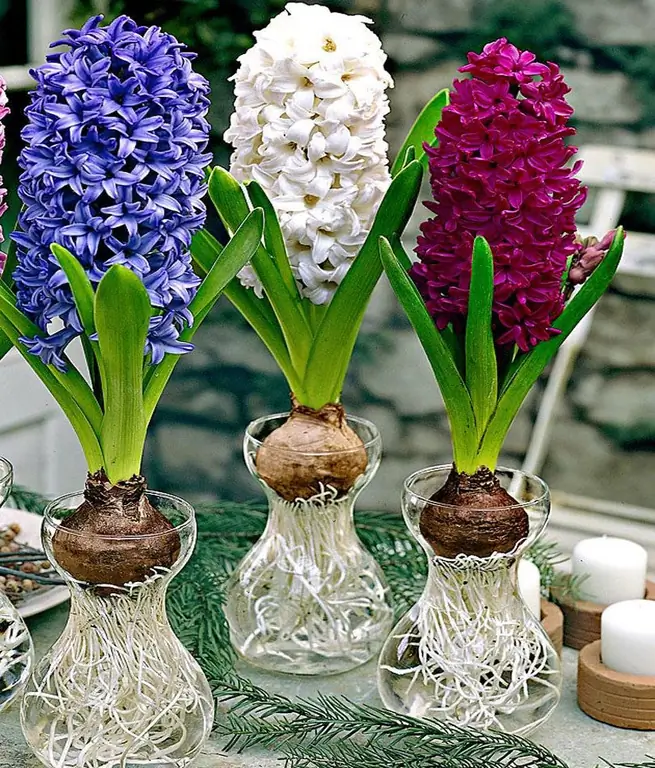
Basic distillation techniques
Planting a hyacinth in a pot at home begins with this process. However, for the full development of the bulbs, the flowerpot should be filled with fertile soil. To create a substrate, it is necessary to take the following components in equal proportions: peat, sand, soddy soil, sheet soil. Everything must be mixed until smooth. Forcing rules:
- A drainage layer is laid on the bottom of the tank, then the substrate is poured.
- Planting material is processed - excess husks and old root shoots are removed.
- Bulbs are immersed in the ground not too deep, 1/3 part. The rest should remain above the soil surface. They usually have a little green bud already on them.
- If, when planting hyacinths at home, several plants are planted in a pot, then they must be placed in such a way that there is space betweenbulbs and flowerpot edges.
- When deciding to grow flowers in a long, rectangular container, one must also adhere to the optimal distance. It should not be less than three centimeters between the sprouts.
- Then the bulbs are watered, but not too much.
- The substrate is covered with a layer of sand. This is necessary so that the plants do not rot during the forcing period.
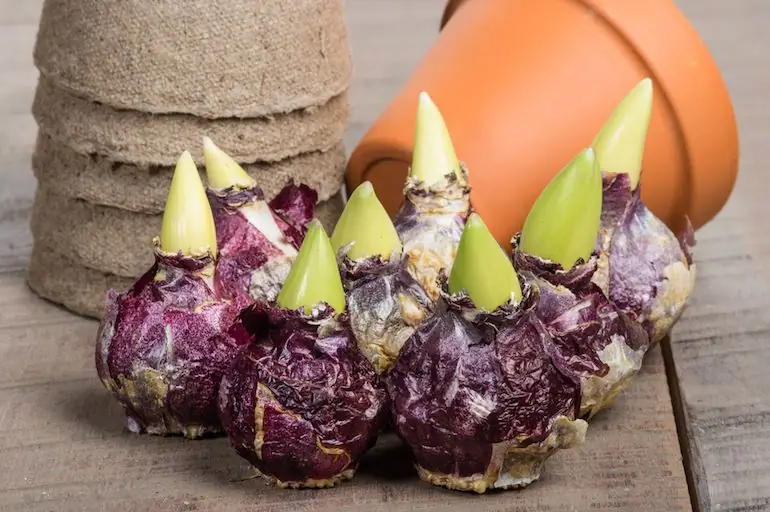
Further observations
The forcing method doesn't end with planting hyacinths, and potting bulbs is part of the process as well. In the first two months, the sprouts should be in the conditions of the street, which will be replaced by the cellar. In this room, the temperature usually does not exceed + 7-8 o C, and this is what is needed for forcing plants. The containers are installed in bags with pre-made holes.
Now, the grower's job is to control the moisture level in the substrate. It must not be allowed to dry out. If the air humidity in the cellar or other room where the sprouts are located is at least 90%, then they should be watered once during this entire period. When they rise to 5 cm, young plants are transferred to the room.
At first, sprouts need darkness. If the apartment does not have such a corner or room, then you can make caps from any opaque material and put them on each hyacinth in a pot. Care at home for plants will begin when the sprouts reach 10 cm in height. As soon as they stretch out, they remove the protection from the lightadaptations and allow them to develop in a new environment for them. It is better that the temperature at this time does not rise above + 15 ° C.
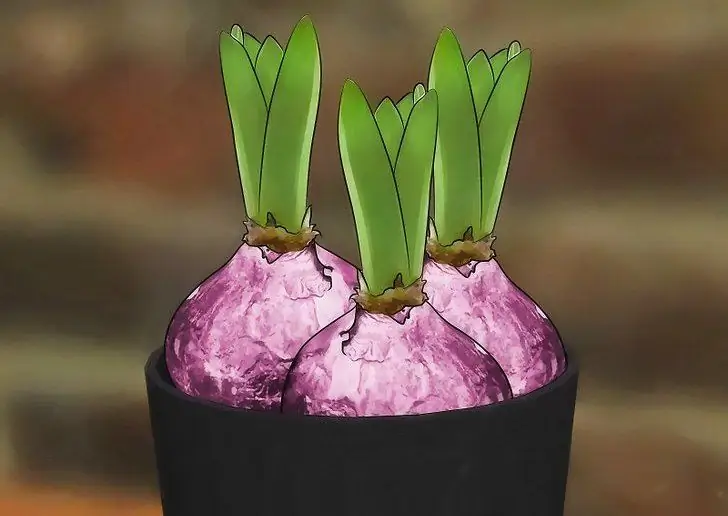
Basic nuances of care
The difficulty of growing a garden plant mainly lies in its non-standard planting. Hyacinth in the home atmosphere, after all the stimulating manipulations, is able to develop independently. The main thing is to carry out watering, fertilizing on time and choose a suitable place for it.
These crops love loose soil. Therefore, after each next application of fertilizers, it is necessary to fluff up the substrate. This should be done very carefully so as not to injure the bulbs.
During the maintenance of these perennials, some secrets were revealed to prolong their flowering, which simply need to be included in the rules of care. Hyacinth in a pot should be taken to a cool room at night and returned in the morning.
After the plant has faded, cut off the stem and leave the leaves. For another month, moisturizing and fertilizing the plant should be carried out. Reduce watering as leaves fade.
The bulbs are carefully removed from the flowerpot and dried. If you plan to plant hyacinths in a home environment later, then they should be kept in the refrigerator. All onions must be carefully examined, the upper peel removed from them, and the unusable ones discarded. It is also advisable to disinfect them with a special solution. For processing, you can use "Fundozol". To exclude infectious lesions, planting material must be held inmeans with the obligatory presence of phosphorus.
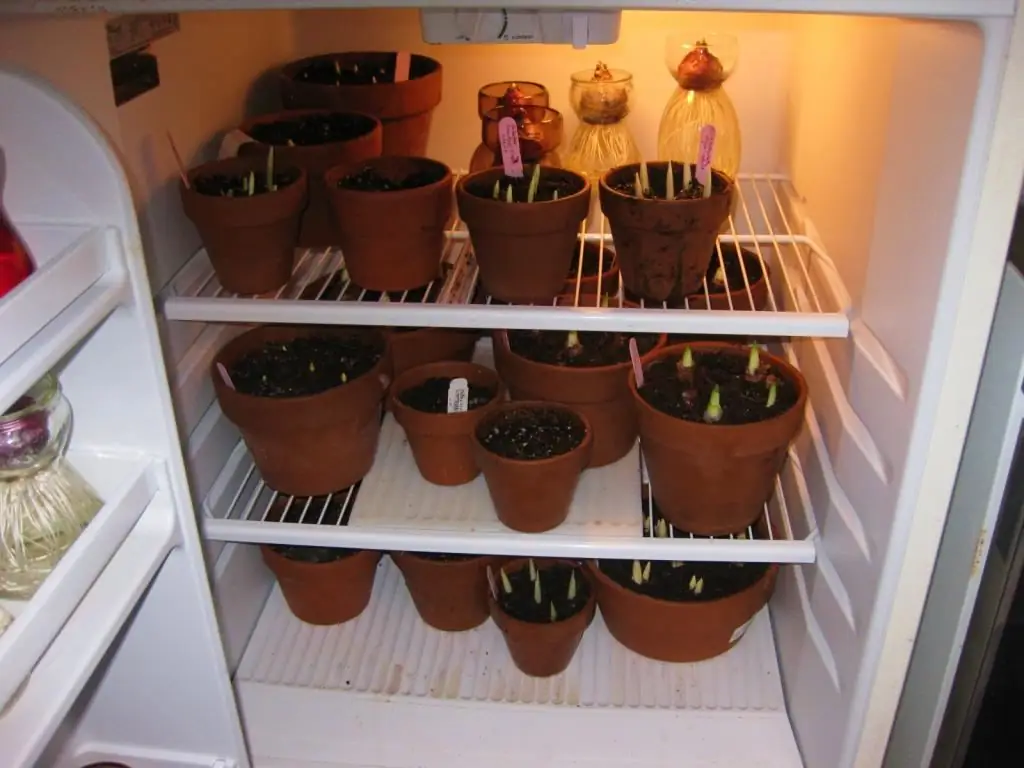
Some flower growers practice growing these specimens in containers without a substrate, immersing the bulbs in water. The root system in this case needs to create a suitable environment for normal growth and nutrition. A complex of mineral fertilizers is added to the water. The bulb should be located on the surface and only touch the nutrient solution with the bottom. Until the lower root processes appear, it must be kept in a cool and dark place.
Since we are talking about growing plants from which you want to achieve the longest flowering period, each stage of caring for it should be considered in more detail.
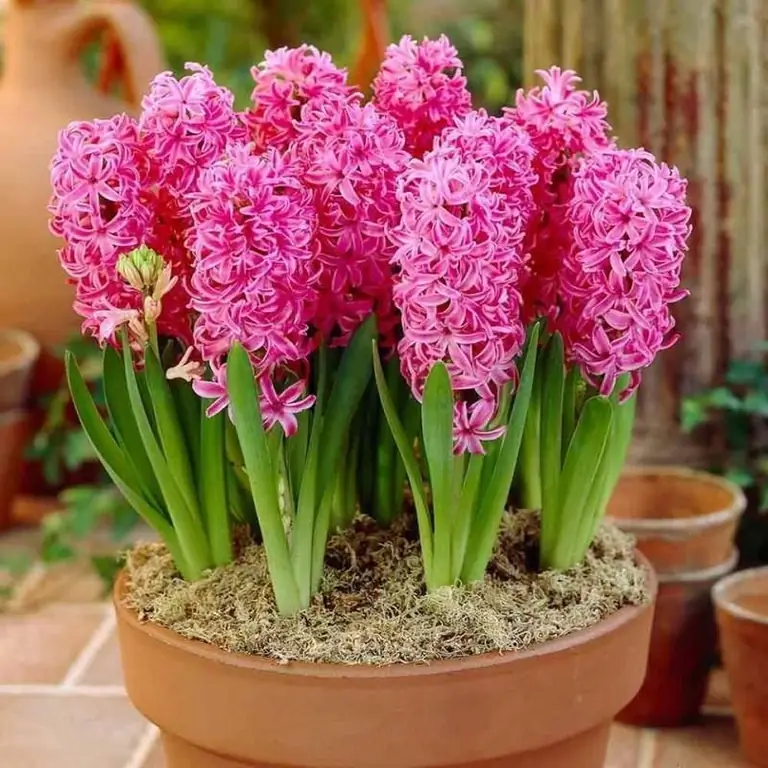
The right place
The ideal location of the flower will be the southeast or south side. Hyacinths have an increased need for sunlight, so they need lighting for fifteen hours a day. The only requirement is that flowers and leaves should not be burned. Flowerpots with plants need to be periodically rotated for uniform light. On very hot days, they need to be shaded. If this is not possible, then it is better to temporarily remove the pots from the windowsill. Without following these rules, it will not be possible to admire the blooming hyacinth tassels for a long time.
If there is no suitable place on open windowsills, then artificial lighting should be created, thus ensuring proper care for hyacinths. Plants in the home microclimatewill be luxurious if you monitor the temperature and humidity.
Temperature
Before the budding period, the bushes are expected to adapt to the home microclimate and be ready for changes. In summer, they can be put on the balcony and open the window at the right time. From the time the first buds appear until the end of flowering, indoor plants need to increase the temperature. The optimal indicator on the thermometer is + 22 o C. In no case should sudden changes in the microclimate be allowed - the flowers will look drooping and ugly.
Feeding and moisturizing
In order for the hyacinth at home to develop no worse than in the flower bed, you need to moisten it and fertilize it in a timely manner. It is impossible to grow these flowers without a competent approach in such matters. Of course, the drainage layer regulates the flow of moisture to the bulb. However, it is important not to forget to pour out excess water from the pan. Maintain moderate humidity.
We must not allow water to linger in the axils of the leaves and buds, as well as on the bulb itself. In this regard, watering must be done along the edge of the flowerpot, otherwise the plant may rot and die as a result. Some flower growers carry out this procedure by immersion. In any case, this must be done carefully with settled and warm water. Given these characteristics of the plant, hyacinths are not sprayed.
Hyacinth growth in fertilized soil is much faster. He needs to ensure a regular supply of nutrients, this is also important for flowering. Here you canuse universal products for indoor specimens purchased at garden stores. In the first days of the flower's stay in the room, it must be fed with nitrogen and phosphate, during budding - with superphosphate with the addition of a small amount of potassium. The last fertilization is carried out before the dormant period. Potassium and superphosphate are diluted in equal proportions, mixed with water and moderately watered plants.
Fight disease
Conditions suitable for hyacinth serve as insurance against diseases. Although it is extremely rare for pests and fungal and bacterial infections, you still need to be aware of these problems in order to process the plant in a timely manner and possibly save it from death.
If yellowing of the leaves is observed, they begin to fade, the root system becomes rotten and rotting is noticed, which means that the insects have already attacked the flower and harmed it. For such cases, you need to have insecticides at home. Although the methods of control in each case are individual and there are drugs of a narrow focus, all types of pests do not tolerate phosphorus.
When plants get sick, their leaves begin to dry out and turn black from the tip of the top. Brown watery lines become visible, both on the stem and along the veins on the leaf blades. Hyacinth bulbs become covered with yellow spots and an unpleasant odor begins to emanate from them. Such a flower is almost impossible to save. It is necessary to eliminate even the substrate in which it grew.
Diseases can be both viral and non-infectious. Commonyellow rot is considered a lesion.
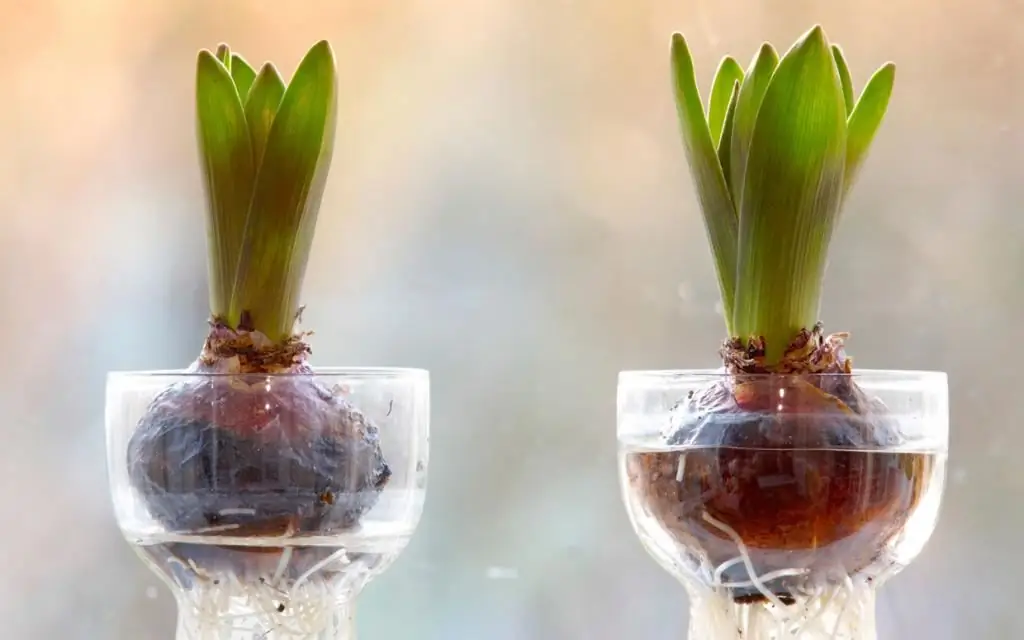
Reproduction
Flowers are propagated by several methods. These include: seed, by cutting and cutting the bottom, by means of children. The latter is usually practiced because it is the simplest. The other two are used in particular by professionals and breeders.
For one year, the root system forms an average of three onions. They must be carefully separated from the mother and placed in another container. It happens that it is impossible to tear off the children from the main bulb. Then they are planted and left together until flowering. Then they are separated. Using this method, flowers can only be obtained after two years.
Growing problems
Flowers with variegated tassels have established themselves as unpretentious and fairly hardy plants. However, in any case, problems with their cultivation may appear.
If the plant suddenly stops blooming, then you need to reduce the temperature regime. Do not forget that hyacinths are spring perennials that do not tolerate heat well.
Due to the presence of drafts and excessive watering, the leaves sometimes turn yellow. Hyacinths get used to a constant temperature, and when a stream of cold air falls on them, they become stressed. Therefore, care must be taken when ventilating rooms.
Falling buds - the result of illiterate moisturizing. This means that the water got on the leaves. It is necessary to dry the plant and water more carefully. It is important to ensure that the peduncle is always dry. Because ofexcessive waterlogging can even rot flowers.
It happens that the whole plant looks normal, but the leaves are a little wilted. This may be due to a lack of sunlight.
Conclusion
Now you already know what a hyacinth is. In fact, this is a flower that can be grown not only by professionals, but also by novice indoor plant lovers. He is as handsome as he is unpretentious. And if you wish, you can get bouquets with numerous bright flowers at any time of the year. Specimens grown simply in water, standing on the windowsill in transparent containers, look very original. In such pots, the bulb floating on the surface and the dense "cobweb" of the overgrown lower root shoots are clearly visible.






